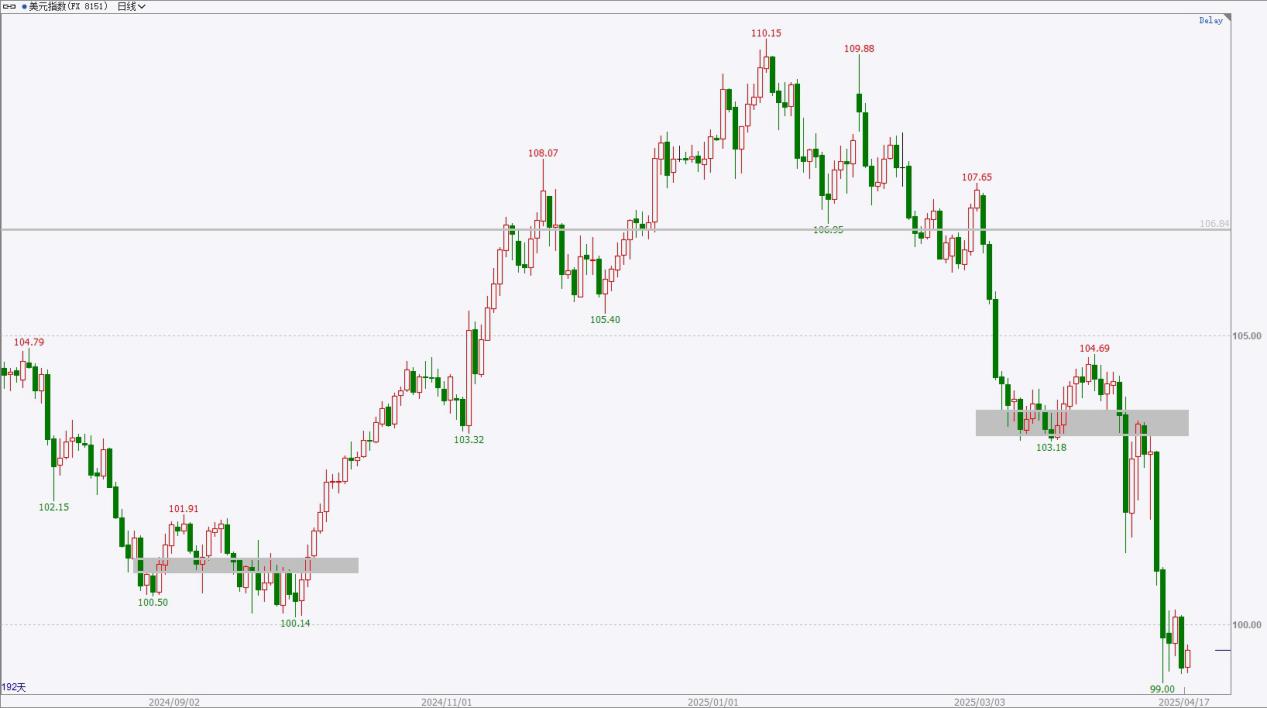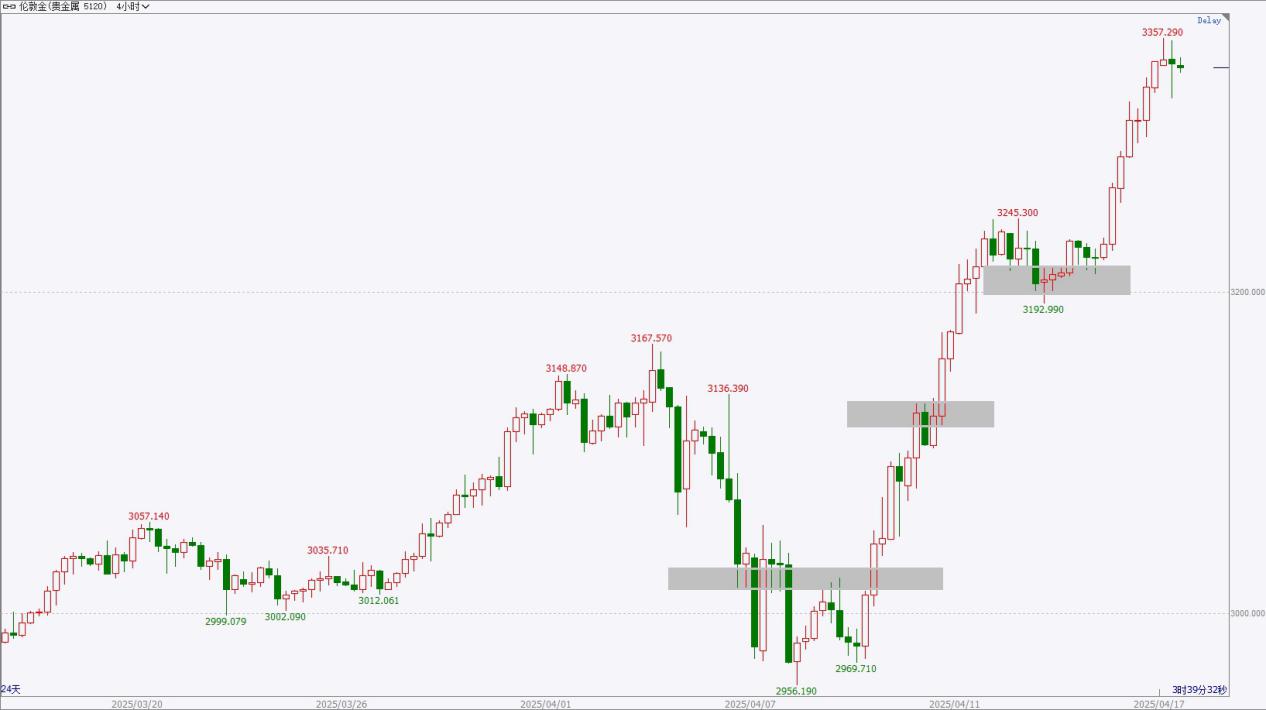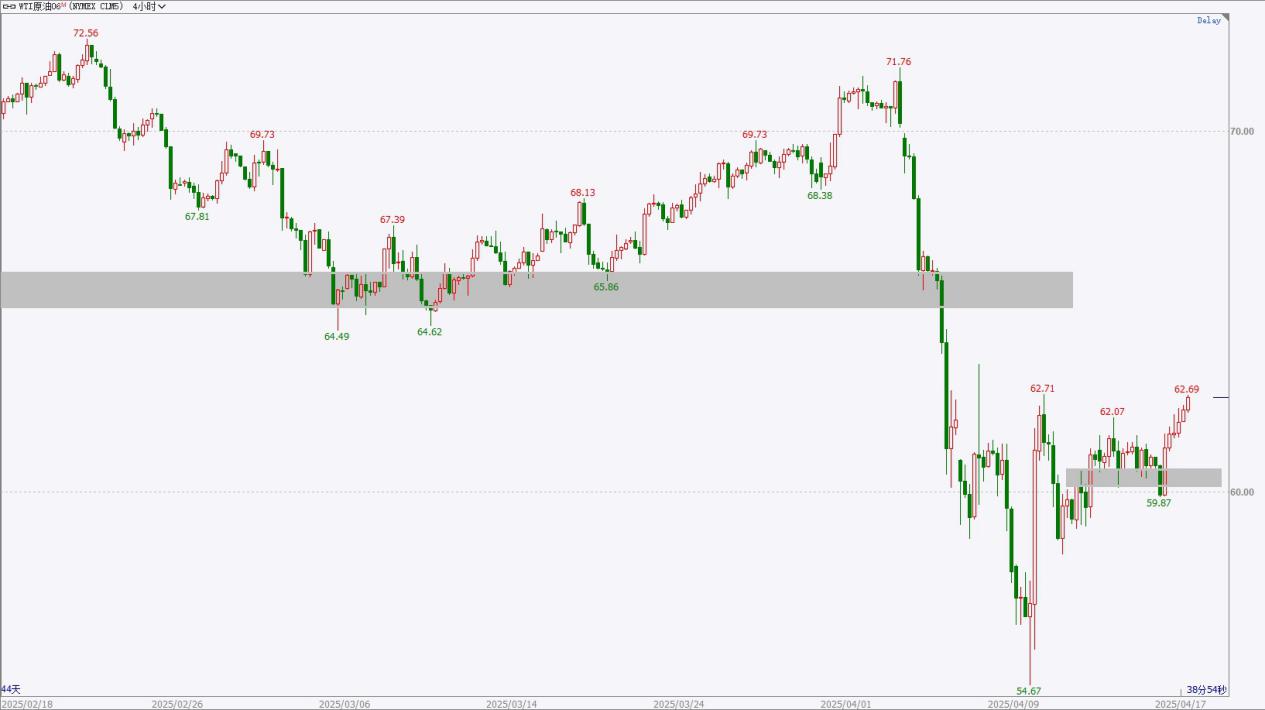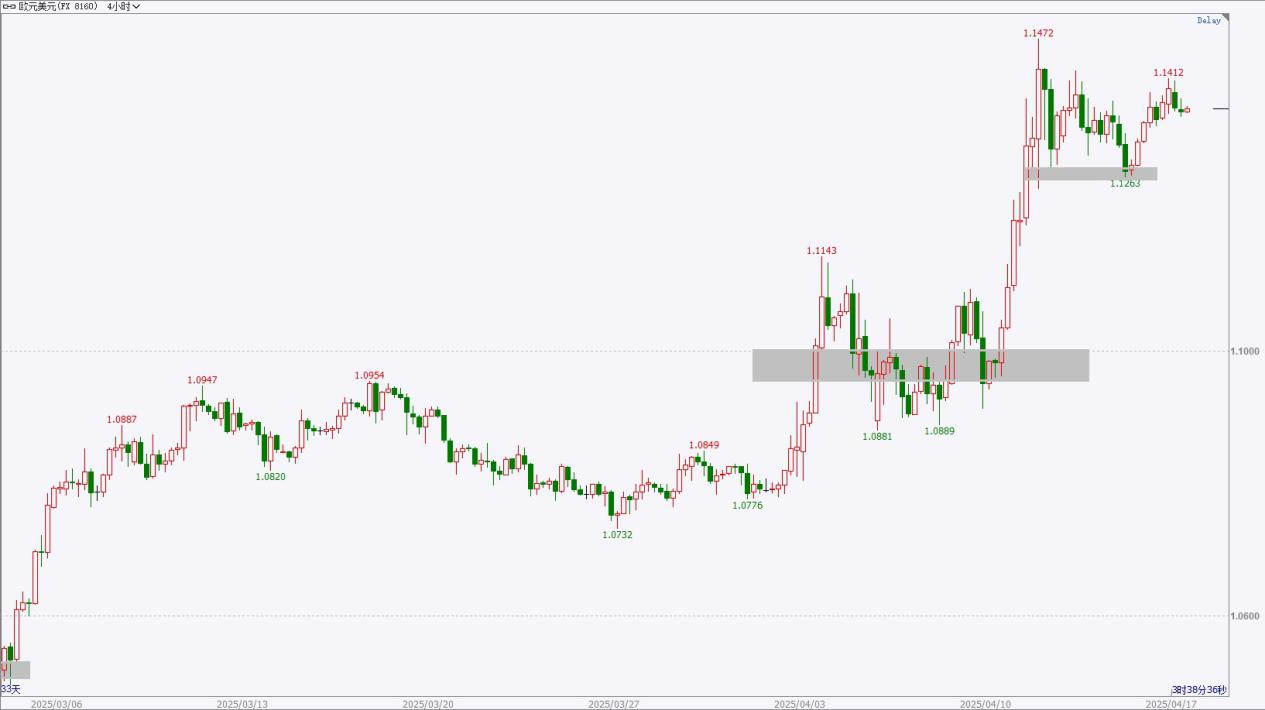|
Time
|
Data and Events
|
Importance
|
|
07:00
|
FOMC voting members Schmidt and Logan discuss the U.S. economy and banking industry.
|
★★★
|
|
09:30
|
Australia’s seasonally adjusted unemployment rate for March.
|
★★★
|
|
14:00
|
Germany’s PPI month-on-month for March.
|
★★★
|
|
Switzerland’s trade balance for March.
|
★★★
|
|
20:15
|
Eurozone ECB deposit facility rate as of April 17.
|
★★★★
|
|
Eurozone ECB main refinancing rate as of April 17.
|
★★★
|
|
20:30
|
U.S. initial jobless claims for the week ending April 12.
|
★★★★
|
|
U.S. new housing starts annualized for March.
|
★★★
|
|
U.S. building permits total for March.
|
★★★
|
|
U.S. Philadelphia Fed manufacturing index for April.
|
★★★
|
|
20:45
|
ECB President Lagarde holds a monetary policy press conference.
|
★★★
|
|
22:30
|
U.S. EIA natural gas inventory for the week ending April 11.
|
★★★
|
|
23:00
|
Federal Reserve Governor Barr speaks.
|
★★★
|
|
Variety
|
Viewpoint
|
Support Range
|
Resistance Range
|
|
U.S. Dollar Index
|
Weak oscillation
|
99-100
|
103-104
|
|
Gold
|
Strong oscillation
|
3200-3220
|
3380-3400
|
|
Crude Oil
|
Short-term rebound
|
56-57
|
65-66
|
|
Euro
|
Strong oscillation
|
1.0950-1.1000
|
1.1450-1.1500
|
*Pre-market views are time-sensitive and limited, are predictive in nature, and are for reference and learning only. They do not constitute investment advice, and the risk of operations is borne by the individual. Investment carries risks; trading requires caution.
Fundamental Analysis:
In the March Federal Reserve meeting, interest rates were kept unchanged, the labor market remained stable, inflation expectations for this and next year were raised, and GDP growth expectations for the next three years were lowered. Starting in April, the pace of balance sheet reduction will slow, and there is uncertainty regarding tariff policies. In March, non-farm payroll data showed an increase of 228,000 jobs, far exceeding expectations, while the unemployment rate slightly rose, indicating a strong labor market. Tariff policies add market risks and uncertainties. The year-on-year CPI for March showed a slight decline, leading to rising expectations for interest rate cuts in the future.
Technical Analysis:

The U.S. Dollar Index fell slightly yesterday, closing with a bearish candlestick, but the short-term cycle did not significantly create new lows. The short-term outlook is oscillatory, currently near the support area, and it is not advisable to excessively short, as it may continue to oscillate or show a rebound. Overall, prices have retreated from high levels, breaking important support areas, and there are no signs of stabilization yet. The upper resistance area is around 103-104, while the lower support area is around 99-100.
Viewpoint: Weak oscillation, prices are close to the support area, and the short-term cycle may oscillate or rebound.
*Pre-market views are time-sensitive and limited, are predictive in nature, and are for reference and learning only. They do not constitute investment advice, and the risk of operations is borne by the individual. Investment carries risks; trading requires caution.
Fundamental Analysis:
The geopolitical conflicts in the Middle East continue to worsen, and there remains uncertainty in the situation in Eastern Europe in the short term. The European Central Bank’s interest rate decision in early March saw a consecutive fifth rate cut of 25 basis points, with inflation progressing smoothly and economic growth risks skewed to the downside. The Federal Reserve’s interest rate decision in March remained unchanged, with a stable labor market, a downward revision of GDP growth expectations, and a slowdown in the pace of balance sheet reduction. In March, the U.S. non-farm payroll data showed that the number of new jobs significantly exceeded expectations, while the unemployment rate slightly increased; the March CPI year-on-year rate saw a slight decline, raising expectations for a Fed rate cut; U.S. tariff policies may stimulate the safe-haven attributes of gold.
Technical Analysis:

Gold prices surged significantly yesterday, closing with a large solid bullish candle, showing strong performance recently without signs of weakening. However, it is not advisable to chase prices excessively; caution is needed for potential short-term adjustments. For long positions, it is recommended to take profits on highs and focus on buying on dips. From a larger cycle perspective, the upward structure is maintained, with a significant rise on the daily chart and new highs without signs of weakening. The upper resistance level may be around 3380-3400, while the lower support level is around 3200-3220.
Viewpoint: Fluctuating with a strong bias, prices have reached new highs; the strategy is to buy on dips and take profits on highs.
*Pre-market views are time-sensitive and limited, are predictive in nature, and are for reference and learning only. They do not constitute investment advice, and the risk of operations is borne by the individual. Investment carries risks; trading requires caution.
Fundamental Analysis:
The April EIA monthly report basically maintains the oil production forecast for this and next year, with a slight downward adjustment to global oil demand for this and next year; the OPEC monthly report slightly lowers the global economic growth forecast for this and next year and revises down the global oil demand growth forecast for this and next year; the IEA monthly report lowers the global oil demand growth forecast for 2025. At the beginning of April, the OPEC+ ministerial meeting maintained the oil production policy unchanged and agreed to exceed expectations for production increases in May. There is uncertainty in U.S. tariff policies, which may affect demand. EIA crude oil inventories saw a slight increase, with a relatively loose supply-demand structure.
Technical Analysis:

U.S. crude oil prices continued to rise after a slight pullback yesterday, with a strong rebound in the short cycle. Current pressure levels show signs of breaking through, and prices are at relatively low levels, indicating a high probability of continued short-term rebounds, making it possible to attempt short-term long opportunities. Overall, crude oil has shown relatively weak performance recently, with prices significantly oversold and no signs of major stabilization yet. The upper small-level pressure area is around 63, while the lower support area is around 56-57.
Viewpoint: Short-term rebound, pay attention to stabilization signals, and attempt to buy on dips.
*Pre-market views are time-sensitive and limited, are predictive in nature, and are for reference and learning only. They do not constitute investment advice, and the risk of operations is borne by the individual. Investment carries risks; trading requires caution.
Fundamental Analysis:
The European Central Bank’s interest rate decision in early March saw a consecutive fifth rate cut of 25 basis points, with inflation declining smoothly and a slight downward revision of GDP growth expectations for this and next year, with economic growth risks skewed to the downside. The Federal Reserve’s March interest rate decision remained unchanged, with an upward revision of inflation expectations and a downward revision of GDP growth expectations, leading to a slowdown in the pace of balance sheet reduction. The U.S. March non-farm payroll data showed that employment numbers significantly exceeded expectations, while the unemployment rate slightly increased; the March CPI year-on-year rate saw a slight decline. In the Eurozone and economies like France and Germany, the manufacturing PMI values were slightly better than previous and expected values. Attention is on the ECB interest rate decision on Thursday.
Technical Analysis:

The euro price saw a slight increase yesterday but failed to significantly reach new highs. The short cycle shows a fluctuating structure, with potential selling pressure above, necessitating caution for potential price pullback risks. For long positions, it is advisable to take profits on highs. Overall, the larger cycle’s upward structure remains intact, with no signs of weakening. The upper pressure area is around 1.1450-1.1500, while the lower support area is around 1.0950-1.1000.
Viewpoint: Fluctuating with a strong bias, caution is needed for potential short-term pullbacks, and long positions should take profits on highs.
*Pre-market views are time-sensitive and limited, are predictive in nature, and are for reference and learning only. They do not constitute investment advice, and the risk of operations is borne by the individual. Investment carries risks; trading requires caution.


Daily Reviews
Our award-winning team of analysts provides keen and insightful technical and fundamental analysis to understand daily market news and investment trading opportunities
HTFX Daily Forex Commentary 0417
Time
Data and Events
Importance
07:00
FOMC voting members Schmidt and Logan discuss the U.S. economy and banking industry.
★★★
09:30
Australia’s seasonally adjusted unemployment rate for March.
★★★
14:00
Germany’s PPI month-on-month for March.
★★★
Switzerland’s trade balance for March.
★★★
20:15
Eurozone ECB deposit facility rate as of April 17.
★★★★
Eurozone ECB main refinancing rate as of April 17.
★★★
20:30
U.S. initial jobless claims for the week ending April 12.
★★★★
U.S. new housing starts annualized for March.
★★★
U.S. building permits total for March.
★★★
U.S. Philadelphia Fed manufacturing index for April.
★★★
20:45
ECB President Lagarde holds a monetary policy press conference.
★★★
22:30
U.S. EIA natural gas inventory for the week ending April 11.
★★★
23:00
Federal Reserve Governor Barr speaks.
★★★
Variety
Viewpoint
Support Range
Resistance Range
U.S. Dollar Index
Weak oscillation
99-100
103-104
Gold
Strong oscillation
3200-3220
3380-3400
Crude Oil
Short-term rebound
56-57
65-66
Euro
Strong oscillation
1.0950-1.1000
1.1450-1.1500
*Pre-market views are time-sensitive and limited, are predictive in nature, and are for reference and learning only. They do not constitute investment advice, and the risk of operations is borne by the individual. Investment carries risks; trading requires caution.
Fundamental Analysis:
In the March Federal Reserve meeting, interest rates were kept unchanged, the labor market remained stable, inflation expectations for this and next year were raised, and GDP growth expectations for the next three years were lowered. Starting in April, the pace of balance sheet reduction will slow, and there is uncertainty regarding tariff policies. In March, non-farm payroll data showed an increase of 228,000 jobs, far exceeding expectations, while the unemployment rate slightly rose, indicating a strong labor market. Tariff policies add market risks and uncertainties. The year-on-year CPI for March showed a slight decline, leading to rising expectations for interest rate cuts in the future.
Technical Analysis:
The U.S. Dollar Index fell slightly yesterday, closing with a bearish candlestick, but the short-term cycle did not significantly create new lows. The short-term outlook is oscillatory, currently near the support area, and it is not advisable to excessively short, as it may continue to oscillate or show a rebound. Overall, prices have retreated from high levels, breaking important support areas, and there are no signs of stabilization yet. The upper resistance area is around 103-104, while the lower support area is around 99-100.
Viewpoint: Weak oscillation, prices are close to the support area, and the short-term cycle may oscillate or rebound.
*Pre-market views are time-sensitive and limited, are predictive in nature, and are for reference and learning only. They do not constitute investment advice, and the risk of operations is borne by the individual. Investment carries risks; trading requires caution.
Fundamental Analysis:
The geopolitical conflicts in the Middle East continue to worsen, and there remains uncertainty in the situation in Eastern Europe in the short term. The European Central Bank’s interest rate decision in early March saw a consecutive fifth rate cut of 25 basis points, with inflation progressing smoothly and economic growth risks skewed to the downside. The Federal Reserve’s interest rate decision in March remained unchanged, with a stable labor market, a downward revision of GDP growth expectations, and a slowdown in the pace of balance sheet reduction. In March, the U.S. non-farm payroll data showed that the number of new jobs significantly exceeded expectations, while the unemployment rate slightly increased; the March CPI year-on-year rate saw a slight decline, raising expectations for a Fed rate cut; U.S. tariff policies may stimulate the safe-haven attributes of gold.
Technical Analysis:
Gold prices surged significantly yesterday, closing with a large solid bullish candle, showing strong performance recently without signs of weakening. However, it is not advisable to chase prices excessively; caution is needed for potential short-term adjustments. For long positions, it is recommended to take profits on highs and focus on buying on dips. From a larger cycle perspective, the upward structure is maintained, with a significant rise on the daily chart and new highs without signs of weakening. The upper resistance level may be around 3380-3400, while the lower support level is around 3200-3220.
Viewpoint: Fluctuating with a strong bias, prices have reached new highs; the strategy is to buy on dips and take profits on highs.
*Pre-market views are time-sensitive and limited, are predictive in nature, and are for reference and learning only. They do not constitute investment advice, and the risk of operations is borne by the individual. Investment carries risks; trading requires caution.
Fundamental Analysis:
The April EIA monthly report basically maintains the oil production forecast for this and next year, with a slight downward adjustment to global oil demand for this and next year; the OPEC monthly report slightly lowers the global economic growth forecast for this and next year and revises down the global oil demand growth forecast for this and next year; the IEA monthly report lowers the global oil demand growth forecast for 2025. At the beginning of April, the OPEC+ ministerial meeting maintained the oil production policy unchanged and agreed to exceed expectations for production increases in May. There is uncertainty in U.S. tariff policies, which may affect demand. EIA crude oil inventories saw a slight increase, with a relatively loose supply-demand structure.
Technical Analysis:
U.S. crude oil prices continued to rise after a slight pullback yesterday, with a strong rebound in the short cycle. Current pressure levels show signs of breaking through, and prices are at relatively low levels, indicating a high probability of continued short-term rebounds, making it possible to attempt short-term long opportunities. Overall, crude oil has shown relatively weak performance recently, with prices significantly oversold and no signs of major stabilization yet. The upper small-level pressure area is around 63, while the lower support area is around 56-57.
Viewpoint: Short-term rebound, pay attention to stabilization signals, and attempt to buy on dips.
*Pre-market views are time-sensitive and limited, are predictive in nature, and are for reference and learning only. They do not constitute investment advice, and the risk of operations is borne by the individual. Investment carries risks; trading requires caution.
Fundamental Analysis:
The European Central Bank’s interest rate decision in early March saw a consecutive fifth rate cut of 25 basis points, with inflation declining smoothly and a slight downward revision of GDP growth expectations for this and next year, with economic growth risks skewed to the downside. The Federal Reserve’s March interest rate decision remained unchanged, with an upward revision of inflation expectations and a downward revision of GDP growth expectations, leading to a slowdown in the pace of balance sheet reduction. The U.S. March non-farm payroll data showed that employment numbers significantly exceeded expectations, while the unemployment rate slightly increased; the March CPI year-on-year rate saw a slight decline. In the Eurozone and economies like France and Germany, the manufacturing PMI values were slightly better than previous and expected values. Attention is on the ECB interest rate decision on Thursday.
Technical Analysis:
The euro price saw a slight increase yesterday but failed to significantly reach new highs. The short cycle shows a fluctuating structure, with potential selling pressure above, necessitating caution for potential price pullback risks. For long positions, it is advisable to take profits on highs. Overall, the larger cycle’s upward structure remains intact, with no signs of weakening. The upper pressure area is around 1.1450-1.1500, while the lower support area is around 1.0950-1.1000.
Viewpoint: Fluctuating with a strong bias, caution is needed for potential short-term pullbacks, and long positions should take profits on highs.
*Pre-market views are time-sensitive and limited, are predictive in nature, and are for reference and learning only. They do not constitute investment advice, and the risk of operations is borne by the individual. Investment carries risks; trading requires caution.
Latest Reviews
HTFX Daily Forex Commentary 0819
HTFX Daily Forex Commentary 0815
HTFX Daily Forex Commentary 0812
HTFX Daily Forex Commentary 0811
Choose a Trusted Broker for Trading
Over 300 employees worldwide, more than 1,000 products, top-tier liquidity